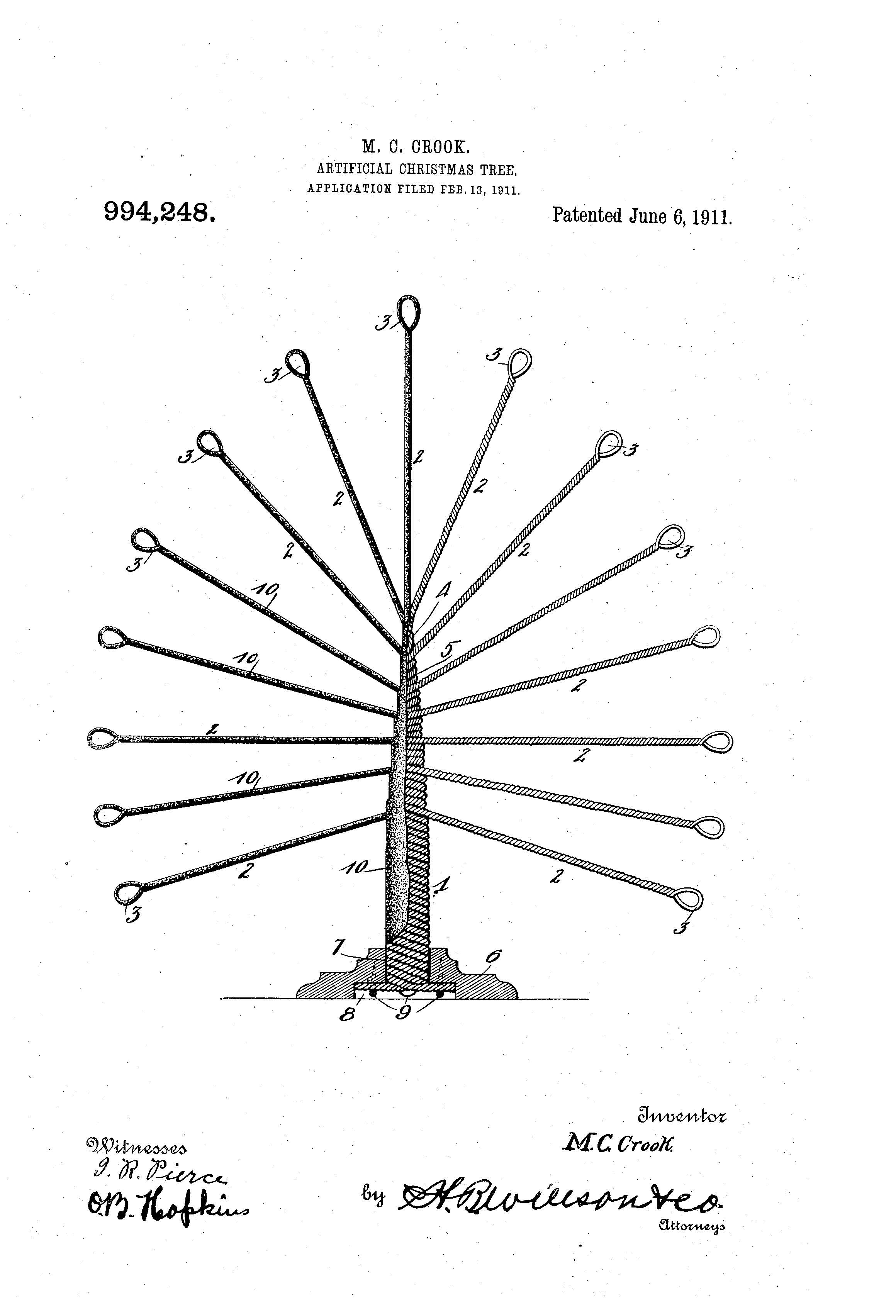Christmas trees are an essential element of Christmas and the holiday season. According to the American Christmas Tree Association’s (ACTA) seventh annual Christmas tree survey, nearly 95 million households across the U.S. will display a Christmas tree this year. Of those Christmas trees displayed, 81 percent will be artificial and 19 percent will be real[1]. And, like any other innovation, Christmas trees have an interesting intellectual property history.
German immigrants brought the tradition of the Christmas tree with them to the United States in the 1700s. German settlers would commonly display community trees in town squares or other public spaces. At that time, many Americans did not accept the notion of a Christmas tree as they associated the trees with paganism. The first recorded instance of an in-home Christmas tree in the United States did not occur until the 1830s.

In 1846, the London News depicted Queen Victoria and Prince Albert with their children gathered around a Christmas tree. Queen Victoria was very popular among the people and almost everything she did became fashionable. Shortly thereafter, Christmas trees began popping up all over Britain. Americans along the East Coast, no stranger to trend setting and fashion, took note of the trend and soon began displaying Christmas trees in their homes.
After the adoption of the Christmas tree as an annual tradition, people soon began inventing ways to decorate the trees. Prior to the invention of the light bulb, people brightened the trees by adding wax candles to recreate the wintertime sight of twinkling stars. Not surprisingly, a tree decked with burning candles created an extreme fire hazard and, as a result, many people lost their homes. Charles Kirchhof tried to alleviate the fire hazard with his invention of the “Candle Holder” (U.S. Patent No. 72,506) which was constructed for conveniently attaching candles, ornaments, or other objects to and maintaining above any oscillating support (as the branches of a tree) in their proper position. This invention was a step in the right direction but an open flame around a tree was still a major concern.
Thankfully, Thomas Edison improved his lightbulb invention and was unsurprisingly involved in the creation of the first Christmas lights (Patent No.  223,898). Edison’s partner and VP of Edison Electric Light Company, Edward Hibberd Johnson, has been called the “father of electric Christmas lights.”. He took Edison’s carbon filament light bulbs, wired them on a strand, and adorned the tree in his house, covering it with 80 red, white, and blue bulbs. The concept quickly spread across the country. President Grover Cleveland requested that over a hundred bulbs be strung on the Christmas tree in the White House.
223,898). Edison’s partner and VP of Edison Electric Light Company, Edward Hibberd Johnson, has been called the “father of electric Christmas lights.”. He took Edison’s carbon filament light bulbs, wired them on a strand, and adorned the tree in his house, covering it with 80 red, white, and blue bulbs. The concept quickly spread across the country. President Grover Cleveland requested that over a hundred bulbs be strung on the Christmas tree in the White House.
 For the longest time, real trees were the only option available to those who wanted the display in their home. One of the first known artificial Christmas trees was invented by Nebraska native Mary Crook in 1911, U.S. Patent No. 994,248. This artificial tree was designed to provide an illusion of a real Christmas tree by having the trunk and branches formed of covered twisted wires to simulate that of natural tree branches. Another aspect was to ensure that the tree was strong, durable, fireproof, and inexpensive.
For the longest time, real trees were the only option available to those who wanted the display in their home. One of the first known artificial Christmas trees was invented by Nebraska native Mary Crook in 1911, U.S. Patent No. 994,248. This artificial tree was designed to provide an illusion of a real Christmas tree by having the trunk and branches formed of covered twisted wires to simulate that of natural tree branches. Another aspect was to ensure that the tree was strong, durable, fireproof, and inexpensive.
New artificial trees are designed for easy assembly; for example, “Artificial Christmas Tree” (U.S. Patent No. 5,855,705) is constructed for a quick assembly and comes with the lights preassembled. If that is too much work, there is the “Pop-Up Christmas Tree” (US 2009/0289560) that has an electrically motorized power antenna assembly. It can be removed from packaging and assembled with a remote control to form a realistic tree.
 One company, Balsam Hill, sells artificial Christmas trees, which are excellent facsimiles of real trees. Their trees have been seen in the Macy’s Thanksgiving Day Parade, movie sets, and in the homes of celebrities. They not only manufacture artificial trees, they also possess patents on the trees such as, “Invertible Christmas Tree” (U.S. Patent No. 8,062,718) and “Collapsible Artificial Tree” (U.S. Patent No. 9,040,130). The invertible tree can be collapsed and stored when not in use. The branches collapse by rotation of one portion of the tree relative to the second portion for a quick and easy disassembly.
One company, Balsam Hill, sells artificial Christmas trees, which are excellent facsimiles of real trees. Their trees have been seen in the Macy’s Thanksgiving Day Parade, movie sets, and in the homes of celebrities. They not only manufacture artificial trees, they also possess patents on the trees such as, “Invertible Christmas Tree” (U.S. Patent No. 8,062,718) and “Collapsible Artificial Tree” (U.S. Patent No. 9,040,130). The invertible tree can be collapsed and stored when not in use. The branches collapse by rotation of one portion of the tree relative to the second portion for a quick and easy disassembly.
Whether you have a real tree, fake tree, or no tree at all, everyone at Suiter Swantz IP would like to wish you and yours a Merry Christmas and a Happy Holiday Season!
[1] American Christmas Tree Association https://www.christmastreeassociation.org/
